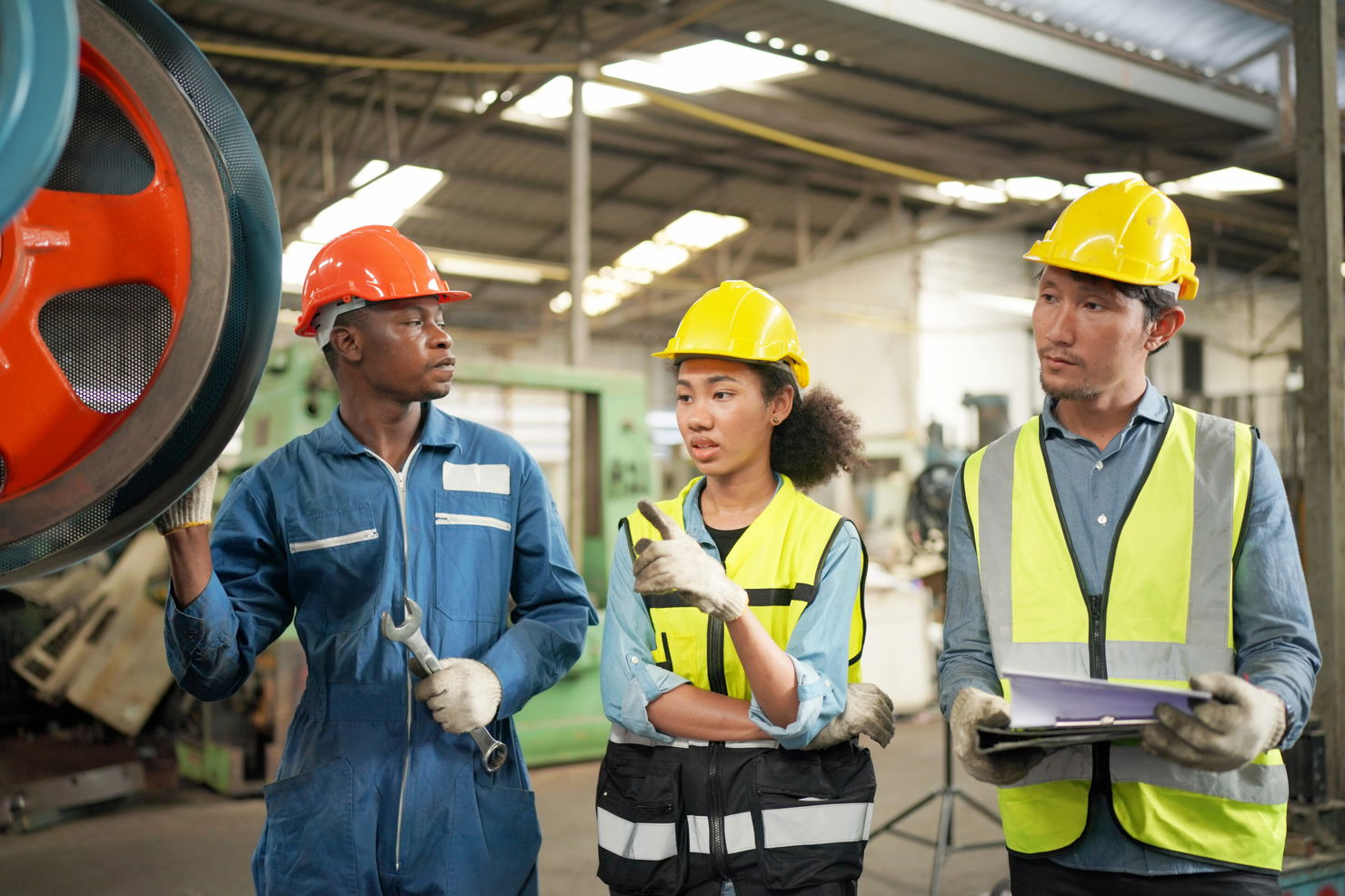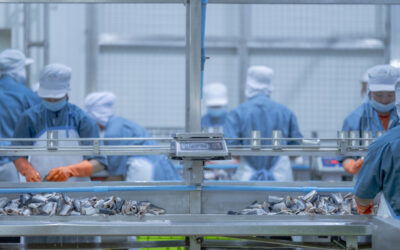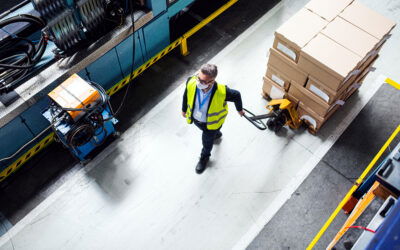Why measure OEE? It’s a question that comes up time and time again on the shop floor. The answer is simple: 35 to 40% of productive capacity remains invisible without measurement. These hidden losses occur every day, representing hundreds of thousands of dollars of unused capacity. A 2-minute stoppage here, a reduced production rate there, a few defective parts… These micro-losses accumulate silently.
At TEEPTRAK, we have supported over 400 plants in 30 countries. The figures speak for themselves: 29% productivity gains on average, and an ROI of less than a month. So the real question is not “why measure OEE?” but “why wait?”. This article reveals the 7 concrete reasons to measure OEE, the true cost of not measuring, and how companies like Hutchinson have transformed their performance.
What does measuring OEE really mean?
The difference between measuring and calculating OEE
Calculating OEE means applying a formula: Availability × Performance × Quality. Any Excel spreadsheet can perform this OEE calculation. Measuring OEE means automatically capturing production data to feed this calculation with reliable information. It’s the difference between estimation and reality.
An operator notes “10 minutes off” at the end of the shift. Was it really 10 minutes or 12? This 2-minute inaccuracy represents a 20% error. Multiply by dozens of daily stoppages: some plants discover that their “75% OEE” is actually 58% measured automatically.
Manual vs. automatic measurement: impact on performance
Manual measurement has three limitations: insufficient accuracy (20-40% deviation), unproductive operator workload, and unusable data. Micro-stops of less than 2 minutes are never recorded. Causes of stoppages are approximate. Production managers pilot blindly.
Automatic measurement via sensors solves these problems. Every stop is captured down to the second. The production process is continuously monitored. The data can be used in real time to take immediate action. As explained in our article on how to calculate the real OEE value, Excel calculates but does not guarantee the reliability of the data.
7 key reasons to measure yield
1. Making the invisible visible: analysis of hidden losses
The first reason to measure OEE: you can’t improve what you can’t see. The big failures are visible. But what about the dozens of micro-stops lasting 30 to 90 seconds? The wear-and-tear slowdowns? These invisible production losses represent 35-40% of your capacity.
Microstops: 45 seconds here, 20 seconds there. Individually negligible. Collectively, 10-15 OEE points lost. Performance degradation: your machine produces 85 parts/hour instead of 100. This 15% loss represents the equivalent of an entire machine.
A packaging plant estimated its OEE at 78% manually. After PerfTrak installation: 58% actual. These 20 points represented €140,000 of hidden capacity annually on a single production line.
2. Data-driven decisions: interpreting results in real time
Without precise measurements, decisions are based on intuition. These impressions are not enough to run a modern factory.
Measurement transforms impressions into certainties: objective prioritization (investing where OEE reveals the greatest losses), factual evaluation (measuring the real impact of modifications at 2% or 10%), transparent communication (“60% of our stoppages come from aging equipment. Replacing it generates €180,000 in annual capacity”).
Performance indicators create a common language between production, maintenance, quality and management. No more sterile debates. The figures are objective, indisputable.
3. Justifying investments: financial strategy and ROI
Obtaining a budget requires solid justification. Management wants figures, ROI. OEE measurement provides these arguments: quantifying the cost of losses (“Our line runs at 62%. We lose 1900 hours a year, i.e. €152,000 of unused capacity”), calculate ROI (“Replacing the conveyor costs €45,000. It causes 8 lost OEE points. Recovering these points generates €65,000/year. ROI: 8 months”).
These arguments speak the language of business. Without measurement, you ask for a budget based on intuition. With OEE, you present a quantified business case. The difference in acceptance rates is radical.
4. Operator commitment: creating a performance culture
One of the underestimated benefits: the impact on team commitment. OEE is not a monitoring tool. It’s a tool for empowerment.
Immediate visibility: real-time dashboards show the instant impact of actions. The operator becomes a player in performance. They know why a machine stops, and how much it costs. Factual recognition: when a team improves OEE from 65% to 73%, the result is measurable and shareable.
End of conflicts: “Why is production low?” becomes the objective. The data show the causes: 60% breakdowns, 25% lack of materials, 15% quality. Everyone acts within their own perimeter.
As our philosophy says: OEE doesn’t improve performance – operators do when they see the truth in real time.
5. Benchmarking: internal and external comparisons for excellence
The measurement enables two essential comparisons. Internal benchmarking: two identical lines, one at 72% OEE, the other at 58%. Why is this? With OEE, you identify differences and duplicate best practices.
External benchmarking: each sector has its own standards. Food industry: 60-75% (frequent changes). Automotive: 75-90% (standardized processes). Aeronautics: 70-85% (extreme product quality).
Knowing your position allows you to set realistic goals. Going from 55% to 85% in one go is impossible. Aiming for 65% then 72% is credible.
6. Pareto prioritization: analysis of priority losses and implementation of actions
50 different causes of stoppage. Where to start? OEE measurement coupled with Pareto reveals: 20% of causes generate 80% of losses. A 64% OEE line reveals that 45% of losses come from 3 stoppages (jamming, conveyor, lack of material).
Without measurement, you treat all causes equally. With Pareto, solving 3 problems recovers 45% of losses, or 12 OEE points. TEEPTRAK integrates this analysis into its dashboards. You can visualize your “top losses” instantly.
Example: a cable factory had 23 causes. Analysis revealed that tension adjustment accounted for 18% of stoppages. By standardizing, the plant gained 6 points in 3 weeks. Cost: 0€. Impact: 15% capacity gain. Implementing targeted actions makes all the difference.
7. Continuous improvement: the importance of a long-term approach
OEE is the foundation of Lean, TPM and Industrie 4.0. Lean eliminates waste. But how can you identify it without measuring it? OEE reveals the 7 mudas: overproduction, waiting, transport, inadequate processes, inventory, movements, defects. It quantifies each waste.
Total Productive Maintenance: autonomous maintenance intervenes when the OEE alerts. Planned maintenance follows measured losses. Industrie 4.0: what can be digitized? What ROI? OEE provides the answers. It’s the data that feeds analyses, predictive algorithms and digital twins.
Without measurement, your initiatives are based on supposition. With OEE, they become quantified, measurable projects. Team collaboration improves. The difference between failure and sustainable transformation.
The true cost of non-measurement
Calculating hidden costs: a practical example
Food packaging line. Estimated OEE: 68%. Opening time: 5000h/year. Capacity : 1000 units/h. Price: €15. Margin: 40%. Actual OEE measured: 58% (10 points less).
Calculation: 10 points = 500h lost/year. 500h × 1000 units = 500,000 units not produced. 500,000 × €15 × 40% = €3,000,000 annual lost margin. Even if we recover 50%, that’s €1.5 million.
Perpetual invisible losses: impact on production time
A 30-second micro-stop, 50 times a day: nobody notes, nobody solves. It will continue indefinitely. Calculation: 30s × 50 × 250 days = 104h/year. At €1,000/h full cost: €104,000/year for a single invisible micro-stop.
Measuring transforms invisible losses into visible, and therefore actionable, losses. The total number of unmanufactured products in relation to the time available reveals the true potential. Overall, visibility is the key.
Competitive impact: loss of market performance
Impossible to optimize lead times: without any knowledge of actual capacity, you promise D+5 when your OEE only allows D+7. Result: delays, dissatisfied customers. Hidden extra costs: overtime, weekends, subcontracting to compensate for unmeasured capacity shortfalls.
Wrong decisions: invest €500,000 in a new line when your current line is running at 58% instead of the possible 75%. Market erosion: your competitor measures and produces at 78%. He has 20% more capacity with the same equipment. More competitive in price, reactive in lead times. He wins. You lose.
Measurement ROI: real figures and results
Hutchinson: transformation thanks to an OEE system
Hutchinson, world leader in automotive and aeronautical rubber/plastics. Initial situation: OEE Excel 47%. TEEPTRAK deployment: PerfTrak sensors, automatic measurement, field dashboards.
12-month results: OEE from 47% to 72% (+25 points). Productivity gains: +53% capacity. ROI: < 1 month. Impact: several million euros recovered.
Keys: real-time visibility, operator commitment, Pareto (80% gains via 20% causes).
Average ROI: less than one month for all our customers
400 plants, 2500+ lines: average ROI < 1 month. Average line: installation €12,000, line cost €800/h, OEE from 62% to 71% (+9 points). Calculation: 9 points on 5000h = 450h recovered. 450h × €800 = €360,000 annual earnings. ROI = €12,000 / €360,000 × 12 = 0.4 months (12 days).
Even with only 5 points, ROI < 3 months. This is the most profitable investment. Optimized uptime pays for the investment immediately.
Average gains: +29% measured productivity
Overall productivity: +29% (from 58% to 75% OEE). Availability: +12% (reduced downtime, predictive maintenance). Performance: +8% (rate degradation detection, micro-stop elimination). Quality: +5% (early detection, scrap reduction).
These gains are measured on hundreds of sites in a variety of sectors. Investment €12,000-18,000 over 3 years. Annual gains €325,000-515,000. The cost of not measuring always exceeds the cost of measuring.
Manual measurement: why it’s no longer enough
Insufficient accuracy: 20-40% deviation from reality
Systematic discrepancy between Excel and measured OEE: 20-40%. Examples: 78% Excel = 58% actual (-20 points). 71% = 62% (-9). 65% = 51% (-14). Causes: selective memory (forgetting small stops), temporal inaccuracy (accumulation of errors), underestimation of micro-stops (< 2min not noted), psychological bias (smoothing of data).
Your Excel displays a reassuringly false OEE. You’re flying with a faulty GPS. The actual manufacturing process eludes you. Every decision based on this data is biased.
Unproductive operator workload: impact on cycle time
15-20 min/entry station. On 3 stations, 250 days: 188-250h/year = 1 month’s work per line. This time is not productive. The operator doesn’t produce, doesn’t solve problems. He fills in Excel at the end of the shift, memory inaccurate, data quality degraded.
With the PerfTrak automatic solution, this time is freed up. The operator concentrates on value: producing, identifying problems, suggesting improvements. Actual cycle time is optimized. Data is captured automatically.
Unusable data: impossible to improve continuously
Even if accurate (never the case), they arrive too late. Data entered today, consolidated tonight, analyzed tomorrow, discussed the day after tomorrow. Problem identified 3 days ago: impossible to remember context.
Without precise time stamping, it’s impossible to correlate quality defects and production events.
Line at 70% speed for 2 hours. End-of-shift discovery (manual) vs. alert after 10min (automatic). Manual data do not feed predictive algorithms. You remain reactive. Continuous improvement requires accurate, complete, real-time data. Manual data entry cannot provide these three qualities. The percentage of compliant products measured in real time makes all the difference.
Measuring OEE: for whom and when?
SMEs vs. large plants: importance for all contexts
Myth: “OEE is for big factories. Reality: even more critical for SMEs. Large plants absorb inefficiencies. SMEs: every point counts, direct impact on profitability.
OEE brings: rapid objectification (2-3 high-impact actions), immediate ROI (a few points = 20-30% margin), professionalization (data-driven management without an army of engineers). TEEPTRAK supports factories with 20 employees as well as groups with 10,000. Scale changes, benefits remain.
Continuous vs. discontinuous production: adapting the space
Continuous (24/7, few changes): OEE focused on availability/performance. Objectives: reduce downtime, maintain output. Targets 80-90%. Discontinuous (frequent changes, batches): OEE integrates changeover time (availability). Objectives: reduce changeovers (SMED), improve start-up yields. Targets 65-75%.
In both cases, the measure is relevant. Only the interpretation differs. Stop counts are adapted to the context.
Ideal timing: when to start setting up?
Short answer: now. Three opportune moments: capacity investment (measure before buying a €500,000 line), Lean/TPM approach (OEE as a base), customers demanding responsiveness (know real capacity).
But the best time: before the problem. When there’s a crisis (delay, loss of market), too late. Reactive mode, pressure, little room for maneuver. Measure = proactive posture. Identify weaknesses before crises. In the end, anticipating is better than reacting. In the long term, this strategy pays off.
Getting started with TeepTrak: a simplified process
2h installation/machine: no production downtime
Fear complexity: “stop production, open cabinets, review network…”. With TeepTrak, none of that. PerfTrak: non-invasive installation, 2h/machine. External sensors (no cabinet opening). Wireless connection (no wiring). No production stoppage (installation while machine is running). Universal compatibility (old and new).
Process: J1 morning audit 1h, J1 afternoon installation machine 1 (2h), J2 machines 2-3-4 (2h each), J3 parameter setting + training (half-day). In 3 days, 4 machines connected and first real-time OEE visible.
Real-time data from D+1: dashboards and alerts
As soon as it’s installed, the data goes up. No learning phase. You see: machine status (start/stop/idle), current OEE (updated in real time), stoppages and durations, history.
Dashboards on workshop screens, field tablets, office PCs, smartphones. Alerts: stoppage > 5min (SMS team leader), OEE < 60% over 2h (email manager), cadence drift > 10% (technician notification).
This reactivity transforms management. You no longer manage end-of-week reports. You manage in real time. Measuring the proportion of losses becomes immediate. Actions follow naturally.
Ongoing support and training
Installing is just the beginning. Value is built over time. TEEPTRAK accompanies you every step of the way. Phase 1 (Month 1): installation, training, configuration, OEE reference. Phase 2 (Months 2-3): identification of Pareto causes, priority projects, methodological support, weekly follow-up. Phase 3 (Months 4-12): extension of other lines, systems integration (ERP, CMMS), advanced training, quarterly reviews.
Ongoing support: 6/7 hotline, updates included, online training platform, user community. Objective: sustainable, measurable results. The 29% average gains are the result of a structured, equipped and supported approach.
High-quality support guarantees success. The benefits are exponential in relation to the time invested.
Conclusion: measuring OEE is a competitive necessity
7 essential reasons: make the invisible visible (35-40% actionable losses), decide with data (no more intuition), justify investments (financial arguments), engage operators (empowerment), benchmark intelligently (relevant comparisons), prioritize Pareto (20% actions, 80% results), build continuous improvement (Lean/TPM/4.0 foundation).
Cost of non-measurement: millions in lost capacity, erroneous decisions, reduced competitiveness. ROI measurement: < 1 month average, +29% productivity, immediate and lasting gains. Inadequate manual measurement: 20-40% deviation from reality, wasted time, unusable data.
The question is no longer “why measure?” but “why wait?”. Every day without measurement = perpetuated losses. Every week without data = missed opportunities. Every month without visibility = lagging competitors.
OEE does not improve performance. Operators do, when they see the truth in real time.
Ready to turn machine data into millions in earnings?
Download our OEE ROI Calculator: find out in just 5 minutes how much your plant could gain from measuring.
Contact the experts for a free audit of your improvement potential:
Should all equipment be measured?
No. Start with bottleneck equipment limiting overall capacity. Once optimized, extend gradually. Rule: 2-5 pieces of critical equipment, results in 3 months, then duplication.
How much does an OEE measurement system cost?
PerfTrak: €10-15,000 initial investment/line, €2-3,000 annual subscription. Total 3 years: €20-25,000. Average ROI 0.5-1 months, i.e. €250-400,000 annual earnings for €20,000 investment.
Does measuring automatically improve OEE?
No. Measuring reveals problems but doesn’t solve them. You need to analyze causes, set actions, engage teams, drive improvement. OEE is a tool, not a magic wand. TEEPTRAK accompanies you through the whole process.
Can you measure without dedicated software?
Technically yes, practically no. Excel generates 20-40% deviation, takes up operator time, provides unusable data. GPS analogy: counting with a paper map is possible, but obsolete. Ditto manual OEE.
How long will it take to see the first results?
Visibility problems: immediate (D+1). First gains: 2-4 weeks. Significant gains: 3-6 months. Transformation: 12-18 months. ROI reached < 1 month in all cases.





0 Comments